TL;DR
Learn how to decorate a bedroom with thrifted finds using seven designer-backed DIY home decor tricks. From painting vintage furniture to styling collections and lighting, these budget decorating ideas help you build an eclectic vintage bedroom over time, not overnight. Expect rules of thumb, measurements, and styling shortcuts you can use today.
Why the slow-collect bedroom is having a moment

Slow-collected thrifted finds create a warm, soulful bedroom corner full of character and charm.
SEO preview: Thrifted bedroom, DIY home decor, eclectic vintage style — seven practical hacks to turn secondhand finds into a 2025-ready sanctuary.
Here’s the thing: DIY isn’t just about saving money anymore. It’s about identity, sustainability, and the pleasure of finding the piece you didn’t know you needed — until you spot it for $30 and sprint to the checkout. Thrifted bedroom decor thrives on patience. Rooms collected over years feel richer, warmer, and oddly calmer than rooms rushed in a weekend haul.
I’ve seen it happen: someone paints two mismatched dressers the same soft green, tucks a vanity into a closet niche, and suddenly the whole space hums. When design is participation, not perfection, a bedroom becomes a living archive — vintage mirrors, a rescued lamp with a starry shade, a small gallery of oil paintings. Let’s turn that energy into a plan.
The slow-collect philosophy
Experts recommend a rolling budget and a 3–5 year horizon, with a 70/30 mix of vintage to new for depth and durability.
Think of your room as a long-form project. Anchor with timeless secondhand wood furniture, then layer textiles, art, and lighting as you find them. Budget decorating ideas work best when you set a few steady rules: consistent color threads, intentional negative space, and lighting that flatters. One thrifter told me she painted walls in Sherwin-Williams Easy Green (matte) to keep an east-facing room bright; the vintage brass and artwork suddenly looked curated, not crowded.
Anecdote
A homeowner once told me she grabbed a thrift-store tiger painting with both hands and dashed to the register — $30 later, it became her palette hero.
DIY HACKS & TRICKS
Start with high-impact moves that cost little and organize a lot.
01. The Color-Linked Furniture Flip (paint thrifted furniture)
Painting mismatched pieces in a shared hue immediately unifies an eclectic bedroom.
How it works: Scuff-sand, spot prime with a stain-blocking primer, then use two thin coats of durable enamel in one coordinating color (greens and warm neutrals read timeless on wood). Designers often advise a 60/30/10 scheme: 60% wall color, 30% furniture color, 10% accents. Swap hardware to bridge eras — antique brass on a simple box dresser, for instance. Matte walls with satin or semi-gloss furniture create subtle contrast and easier wipe-downs. Expect one weekend per piece including cure time.
- Mark drawers and hardware in labeled bags before painting.
- Test a 12×12 swatch by the light you live with morning and night.
- Repeat the hue across two items (desk + tallboy) for instant cohesion.
Alt text idea: Painted vintage dresser and desk in coordinating green with brass knobs. Caption: One color, two pieces, zero visual noise.
02. Closet Niche, Big Payoff (small-space bedroom layout)
Sliding a dresser or vanity into a closet niche frees floor space and creates a built-in look.
How it works: Measure depth; leave at least 18 inches for drawer clearance and 30–36 inches for walkway in front. Aim for 1 inch of breathing room on each side and add felt sliders to protect floors. Layer task light — a clip-on lamp or mini pendant — and finish with a curtain or cafe door if you want to hide visual busyness. In older homes, this single move can make a room feel a size up.
- Use a low-profile surge strip with a right-angle plug for clean cables.
- Top with a mirror at 57 inches to centerline — museum height.
- Style with a tray to corral perfumes and daily jewelry.
Alt text idea: Vintage vanity tucked inside closet niche with mirror and pendant. Caption: Borrow space from the closet, give it back to the room.
03. Gallery-with-a-Story Wall (eclectic vintage art)
Mix oil paintings, mirrors, and prints to add scale and softness without buying a giant headboard.
How it works: Start with your largest piece centered 6–8 inches above the furniture below. Keep 2–3 inches between frames and balance weights, not perfect symmetry. A rule of thumb many designers use: hang artwork so its center sits around 57 inches from the floor. Unify mismatched frames with a shared metal finish or a painted frame refresh. I once watched a $30 thrift-store tiger painting become the conversation piece that set the room’s palette.
- Lay the arrangement on the floor first, then transfer to the wall.
- Use paper templates and painter’s tape to test scale.
- Add one convex or starburst mirror to bounce light.
Alt text idea: Mixed vintage gallery wall over thrifted headboard. Caption: Collected, not crowded.
04. Atomic-Star Lamp Shade DIY (retro lighting upgrade)
A thrifted shade, tissue paper, and vinyl decals turn a plain lamp into mid-century whimsy.
How it works: Decoupage pink or cream tissue inside the shade in overlapping strips, aiming for 40–60% opacity so light glows without glare. After it dries, add star decals outside for crisp silhouettes. Pair with a 2700K LED bulb to keep the warmth. This quick project costs under $20 and gives a vintage base new personality.
- Use matte Mod Podge so the interior doesn’t hotspot.
- Trim edges with bias tape or gold vinyl for a tailored finish.
- Choose a drum shade 60–70% the height of the lamp base for balance.
Alt text idea: Pink tissue-lined lamp shade with atomic star decals. Caption: Glow up, literally.
05. Jewelry-as-Art Curio (brass wall cabinet)
A shallow glass-front cabinet turns necklaces and brooches into decor while keeping them tangle-free.
How it works: Mount into studs (typically 16 inches on center) or use heavy-duty anchors rated for the cabinet’s weight. Line the back with linen or velvet and add tiny cup hooks in a 2-inch grid. For ergonomic access, set the cabinet bottom around 48 inches from the floor. One homeowner hunted down a brass-and-glass cabinet after seeing it online and has moved it from space to space — proof that utility pieces can be heirlooms.
- Group by metal tone for a boutique feel.
- Stash rings in shallow vintage salt cellars.
- Add an LED puck light for museum vibes.
Alt text idea: Brass wall cabinet displaying necklaces and earrings. Caption: Storage that doubles as sparkle.
06. The 70% Shelf Rule (display collections without clutter)
Dedicate one shelf to a single subject — cats, deer, unicorns — and fill no more than 70% of the volume.
How it works: The remaining 30% negative space keeps visual breathing room in maximalist decor. Use risers (stacked books, acrylic blocks) to vary heights, and group in odd numbers — 3, 5, 7 — for rhythm. Trays corral tiny pieces so dusting takes minutes, not hours. I’ve seen a “shelf of cats” look charming because it was themed, spaced, and lit softly from below.
- Install an LED strip tucked under the shelf lip for a gentle wash.
- Stick museum gel under breakables to earthquake-proof.
- Rotate seasonal pieces to keep the vignette fresh.
Alt text idea: Themed figurine shelf with varied heights and negative space. Caption: Curated, not chaotic.
07. Vanity Vignette, Nostalgia Edition (vintage perfume styling)
Empty vintage bottles and a pretty tray make a vanity feel cinematic — even if you refill them with modern scents.
How it works: A 10–12 inch tray is usually enough for daily-use perfumes and a small vase; add a mirror behind to bounce light. Keep pieces at least 6 inches from the edge for a tidy silhouette. Designers often advise arranging in a triangle composition — tall at the back, medium mid, small front — for instant balance. One collector keeps a retro “Juice Bar” bottle on display for the memory alone, and it sparks joy every morning.
- Use non-skid liners so bottles don’t migrate.
- Mix glass, lacquer, and brass for layered sheen.
- Tuck a microfiber cloth under the tray for dust duty.
Alt text idea: Vintage perfume tray on vanity with mirror. Caption: Scent as story.
What ties it all together
What ties these ideas together isn’t just frugality — it’s intention. Each project rescues materials, favors warmth, and makes room for your history. A practical tip designers repeat: repeat color, vary texture. That’s how a space feels cohesive yet collected.
And yes, let it take time. A reader told me she thrifts two to three times a week and still leaves empty-handed often. The magic is in the long game.
Visualize before you DIY
Previewing paint, art layouts, and lighting digitally saves time, money, and patchwork holes in your wall.
Before you pick up a brush or rearrange your room, test ideas in a virtual mockup. Upload a photo to ReimagineHome, swap wall colors, try the 57-inch art centerline, or see how that green dresser anchors the bed wall. You can audition lamp shades, gallery walls, even closet-niche layouts in seconds — and walk into the weekend with confidence.
Visualization Scenario
Upload your bedroom photo to ReimagineHome, test Easy Green walls versus a muted cream, place a vanity in the closet niche, and preview a 7-piece gallery hung with 2–3 inch spacing before you make a single hole.
FAQ
How do I decorate a bedroom with thrifted finds without clutter?
Limit displays to 70% of shelf space, repeat 2–3 colors, and group collections by theme to feel curated instead of chaotic.
How long should I spend curating an eclectic vintage bedroom?
Experts suggest a 3–5 year horizon with a rolling budget, prioritizing quality wood furniture first, then textiles, art, and lighting.
What paint finish is best for thrifted furniture in a bedroom?
Satin or semi-gloss enamel is durable and wipeable; pair with matte or eggshell walls for soft contrast.
How high should I hang art above a dresser or vanity?
Use the 57-inch centerline rule and keep 6–8 inches between the top of the furniture and the bottom of the artwork or mirror.
How can I make a small bedroom feel bigger with vintage decor?
Tuck storage in a closet niche, use mirrors to bounce light, and keep pathways 30–36 inches wide for easy flow.
Live in the making
Rooms that move us aren’t showroom-perfect; they’re evidence of a life unfolding. In 2025, the best thrifted bedrooms feel personal, practical, and a little nostalgic — the glow of a starry lamp, the wink of a brass mirror, the quiet pride of a desk you repainted yourself. Let the process change you. Add one piece, edit another, and keep returning to the room you actually use. When you’re ready to visualize the next iteration, let ReimagineHome be your sandbox.
.svg)

.svg)

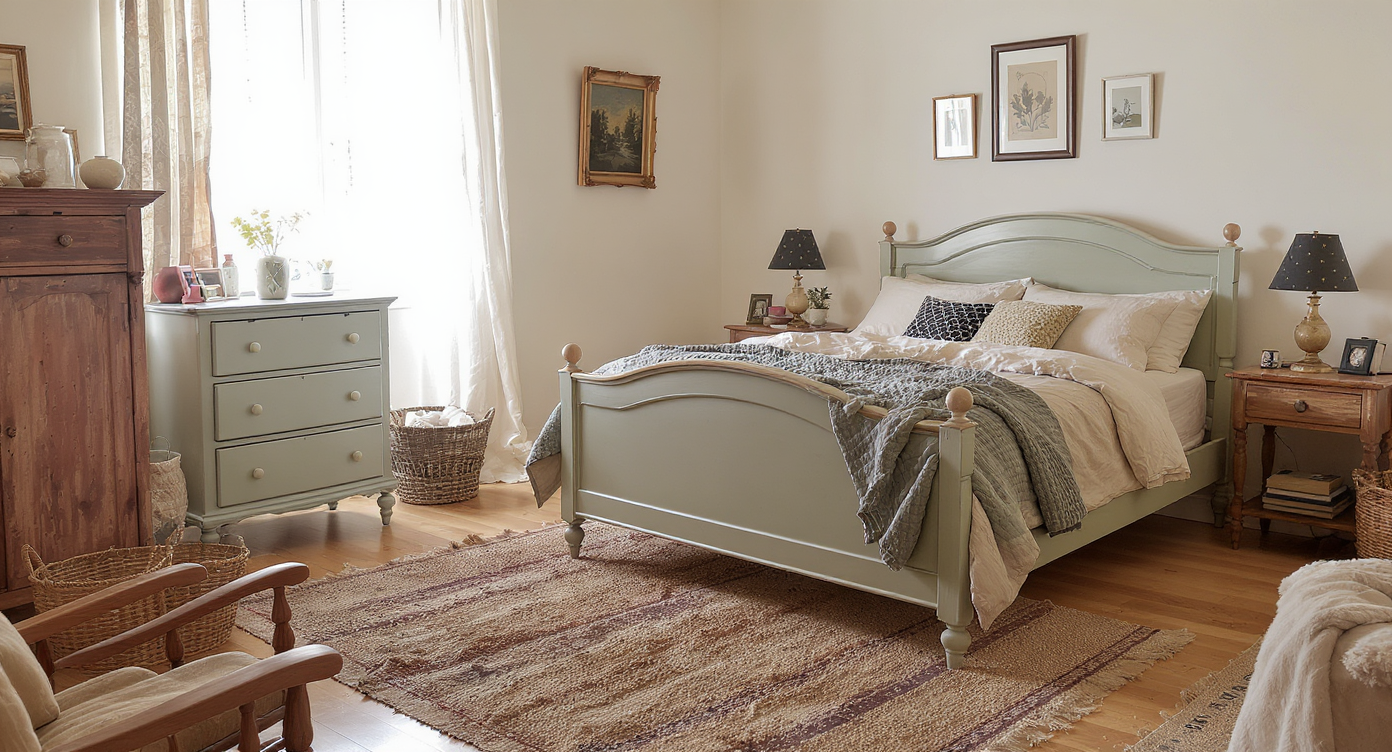


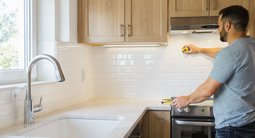

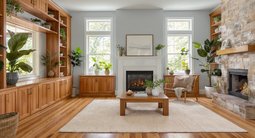
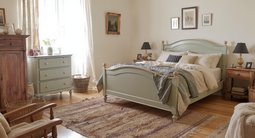



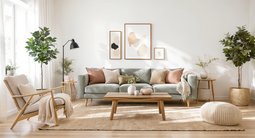


.png)